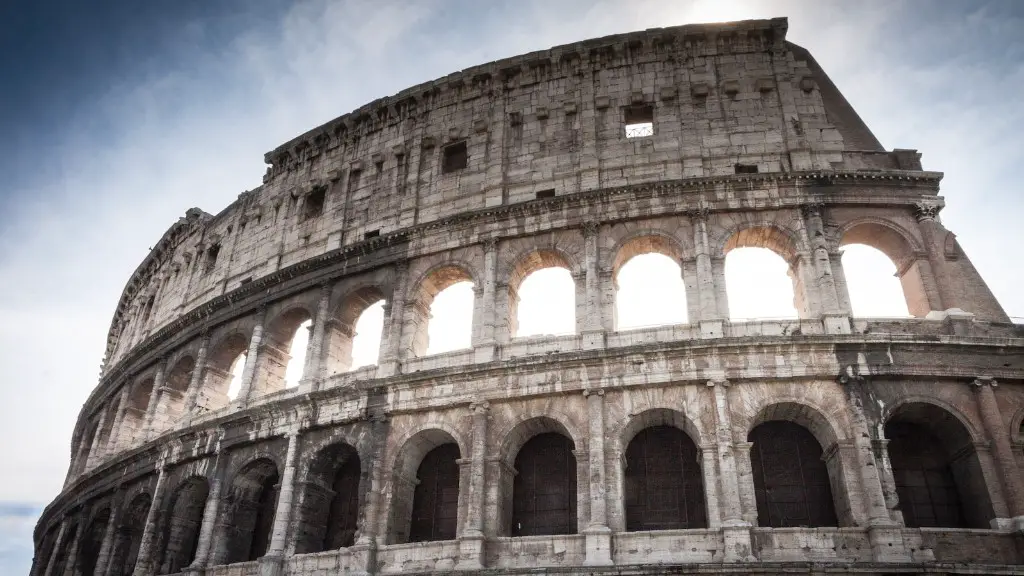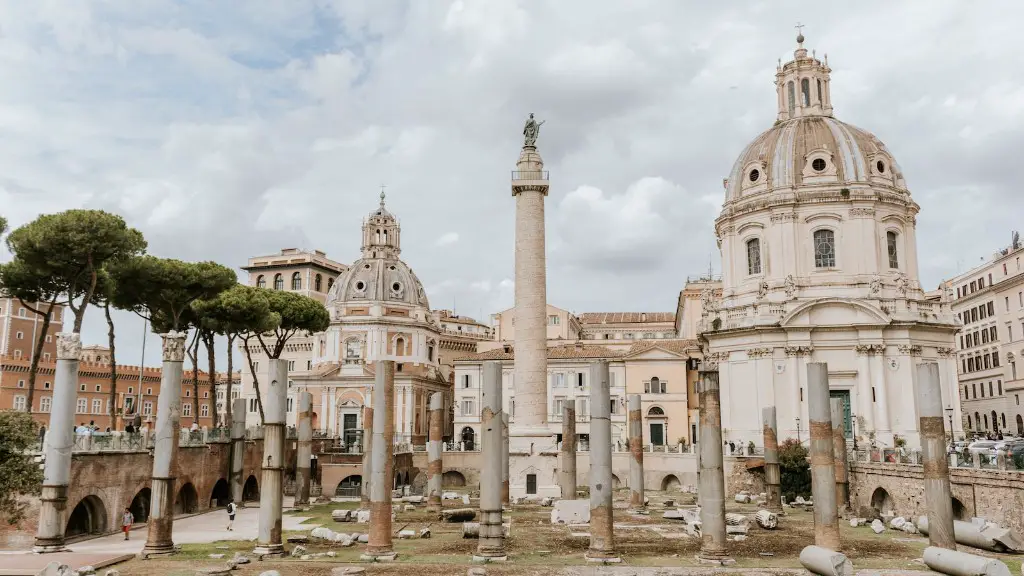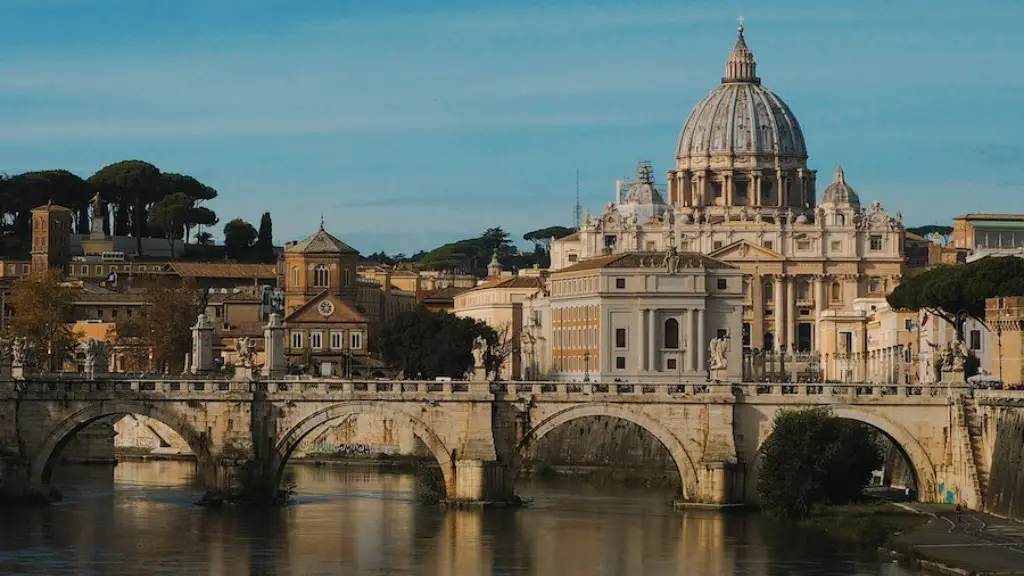The Colosseum is one of the most iconic structures in Ancient Rome. Located just east of the Roman Forum, the Colosseum was the largest public gathering place in Rome. Built between 72 and 80 AD by Emperor Vespasian, the Colosseum served as a place for spectacle and entertainment for a population that had never seen anything quite like it. The Colosseum was built to host events such as gladiatorial fights, animal hunts, and public executions.
The Colosseum was an engineering marvel and was the largest amphitheatre of its kind. It measured 189 meters long, 156 meters wide, and stood 48 meters tall and could accommodate 50,000 to 80,000 spectators. It was made up of 80 entrance arches with a floor made of wooden planks covered with sand. The general form of the Colosseum has been used repeatedly in the design of stadiums around the world.
In addition to its amazing size, the Colosseum also featured advanced engineering and architectural features. Inside the Colosseum, the arena floor was covered in a wooden floor with channels for water and a system of winches, ropes, and pulleys that was used to lower structures into the arena. There were also ramps, walled stairwells, and arched passageways, as well as travertine stone walls and marble glazed tile floors.
The Colosseum also featured a number of other spectacular features. Around the arena floor were underground storage rooms for animals and props. The upper levels of the Colosseum featured box seating for the emperor, members of the Senate, and the wealthy. The Colosseum also had copper brackets that could be used to hold banners, flags, and other items. Outside the Colosseum, visitors were met with a towering bronze statue of Nero.
As one of the most impressive ancient structures, the Colosseum has been a popular destination for tourists and historians alike. Unfortunately, due to the heavy damage and destruction the Colosseum has suffered over the years, much of its original grandeur has been lost. Despite this, the Colosseum remains a powerful symbol of the grandeur and power of Ancient Rome.
How Was the Colosseum Built?
The construction of the Colosseum was an incredible feat of engineering and architecture for its time. Much of the structure’s striking features are the result of the many years of painstaking effort that went into its design and construction.
The Colosseum was built using a variety of materials and techniques. The foundation of the Colosseum was made from blocks of tuff which was quarried from the nearby hills and then transported to Rome. The tuff was then carved into blocks and laid in an overlapping pattern to form the foundations. On top of this, a series of brick piers were built, and upon these were placed the travertine stone walls of the Colosseum.
The archways in the Colosseum were made from sandstone and limestone, and the upper levels were made from terracotta and stucco. The ceiling and walls of the Colosseum were made from intricate designs and ornaments of marble and stone, and the arches, stairs, and galleries were held together with iron clamps.
The construction of the Colosseum also involved the creation of a number of other impressive structures and features. These included the creation of underground passages and cells designed to house animals, props, and gladiators. Additionally, the Colosseum featured a hypogeum which was designed to help cool portions of the arena with cool air.
Impact of the Colosseum on Society
The Colosseum was a powerful symbol of the power and influence of the Roman Empire. The Colosseum was seen as a place of entertainment, spectacle, and even capital punishment. It was a place of great fear and awe for the citizens of Rome, who were both drawn to its spectacle and repelled by its violence.
The Colosseum also had a tremendous cultural impact on Ancient Rome. Events such as gladiator fights and chariot races served as a source of entertainment and escape from the daily grind of life. The Colosseum also played an important role in the shaping of Ancient Roman society. As an impressive engineering feat, it was a powerful symbol of the sophistication and power of the Roman Empire. It also served as a reminder of the emperors’ wealth and power, and was used to reinforce the emperor’s authority.
In addition, the Colosseum was a major influence on the architecture and engineering of later eras. It was the first example of a large-scale Roman structure that combined elements of the Classical and Hellenistic eras, and the use of arches, barrel vaults, and classical ornamentation influenced the designs of architects for centuries. The Colosseum’s influence on architecture can be seen in its lasting impact on later structures such as the Pantheon in Rome, the baths in Tunisia, and the Triumphal Arch in Paris.
Preservation of the Colosseum
Throughout history, the Colosseum has suffered from neglect and damage, many of which were caused by the barbarian invasions that occurred during the 5th century. Over the centuries, the Colosseum has been pillaged for its materials and its walls have been used as a source of stone for other buildings in Rome. However, in the 19th century, steps were taken to preserve the Colosseum and it was declared a national monument in the 1880s.
Since then, numerous restoration projects have been undertaken to help preserve the Colosseum. In 2013, the Colosseum underwent a 29 million Euro restoration. This restoration included the installation of advanced lighting systems, a new ventilation system, and new security measures. Additionally, part of the Colosseum was opened to the public in the form of an underground museum that showcased the ancient engineering marvels beneath the arena.
Conservation Efforts Today
In recent years, conservation efforts have been undertaken to help preserve the Colosseum and its history. In 2020, the European Union provided funding for a restoration project which included repairs to the walls, the installation of a new drainage system, and the advancement of the arena’s technical features. Additionally, UNESCO has recognized the Colosseum as a World Heritage Site and continues to work to preserve it for future generations.
In addition to state-funded projects, conservation efforts are also taking place on an individual level. Private citizens have begun donating to the preservation of the Colosseum, and in 2014, a group of volunteers was formed to help with the restoration and maintenance of the Colosseum.
Conclusion
The Colosseum is undoubtedly one of the most iconic and impressive structures of the ancient world. Not only was it an impressive engineering feat, but it also had a tremendous impact on Roman society and culture. While it has suffered from the ravages of time, there are numerous conservation efforts underway to help protect and preserve this ancient structure. It is a testament to the ingenuity and greatness of the Roman Empire, and a reminder of its lasting legacy.




